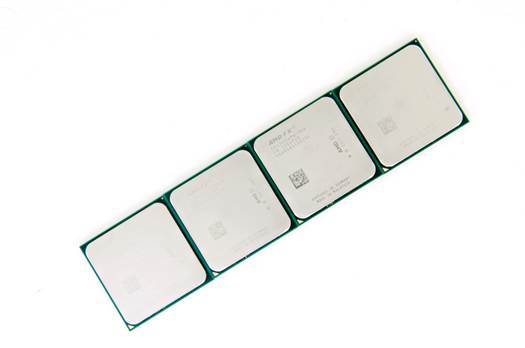I have to say that the results of this test
practically confirmed what we have seen in the first review of Socket
AM3+ processors with Piledriver microarchitecture. The sole difference is that
this time we looked not only at the top CPU model, but also at the entire series.
And this allowed us to somewhat revise our attitude to new AMD products. This
is the main reason.

Vishera
Processor series
The flagship FX-8350 really looks
interesting. It is remarkably faster than the previous generation AMD
processors and can compete successfully against top LGA 1155 Ivy Bridge CPUs in
case of multi-threaded load. Bearing its affordable price in mind, FX-8350 can
be recommended for budget desktop configurations dealing mainly with
resource-demanding tasks such as HD content creation and processing or final
rendering. Though, it is also important to take into account that some of its
drawbacks before you decide on this product. This processor is hugely power-consuming,
and on top of that it is not popular as it doesn’t work fast in daily general-purpose
tasks, which can’t almost divide the load into eight parallel threads. I would
also like to point out that 3D games are also among the tasks that concern AMD
processors.

FX-8350
can be recommended for budget desktop configurations dealing mainly with
resource-demanding tasks.
But, if you like FX-8350, then you should
also take FX-8320 into account. This model is much cheaper, but offers actually
the same level of performance – it will do great in professional apps. Additionally,
because all contemporary Socket AM3+ processors belong to the Black Edition
series, meaning having unlocked clock frequency multipliers, FX-8320 can easily
be overclocked to the level of the top CPU or even beyond that. This let us
state that AMD FX-8320 is one of the most interesting options for computer
enthusiasts, in accordance with price-to-performance (multi-threaded). I wish
it could eliminate the downsides that Vishera have: high power consumption and
low performance in lightly-threaded applications. So, to be fair, FX-8320 is a
good niche product, yet not a general solution.
The six-core Vishera variant, FX-6300,
seems to make a pretty weak overall impression at first sight. One of the four
dual-core modules in this processor is disabled, which is the reason why its maximum
performance is relatively low, compared with Intel’s quad-core processors even
under multi-threaded load. This is pretty rational, because two contemporary
AMD cores are mostly as fast as one Intel core: this is exactly what we saw via
our test. Nonetheless, the first impression is not always right, and it
immediately fakes out once you check out the price list. AMD evaluated their
FX-6300 in a way to turn it as a direct rival against Core i3, instead of Core
i5. And this strategy gives Vishera new possibilities: they can be regarded as an
interesting in comparison with Intel’s dual-core processors. In addition, in
this case FX-6300 even has a little superiority. For instance, it can be
overclocked unlike Core i3 processors.
Regardless all, the youngest memory of the
new Vishera series, FX-4300 processor, turned out completely disappointing.
Here, AMD was obviously brought away when cutting off its function: they not only
disabled half of its cores but also took away half of the L3 cache memory. As a
result, FX-4300 is no faster than FX-4170 with Bulldozer microarchitecture and
just a bit more energy-efficient than the latter. Therefore, the quad-core
Vishera processor is considerably slower than Intel Core i3, but at the same
time its price is very close to that of FX-6300. So, it looks like this
particular processor won’t likely to interest loyal AMD fans that prefer to
choose a similarly priced A10-5800K with an integrated graphics core and higher
clock frequencies.

Regardless
all, the youngest memory of the new Vishera series, FX-4300 processor, turned
out completely disappointing.
Well, the seduction of AMD processors with
Vishera design is not really the Piledriver microarchitecture’s advantage, but
their low prices are. In this respect, the two models in the middle models of
the series, FX-8320 and FX-6300, seems the best. These are processors which
should be recommended, if you are not disappointed by higher power bills. Plus,
please remember that AMD processors perform best in multi-threaded tasks, yet
they are not as common as Intel products. Thus, Socket AM3+ platform probably
won’t be a good choice for daily usage, while it will suit an inexpensive
workstation system best.